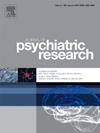Local connections enhancement as a neuroprotective strategy against depression recurrence: Insights from structural brain network analysis
IF 3.7
2区 医学
Q1 PSYCHIATRY
引用次数: 0
Abstract
Background
Depression recurrence significantly impacts patients' well-being and presents a major clinical challenge. Identifying the risk of recurrence during remission could enable early intervention and prevent disease progression.
Methods
This study included 115 patients in remission from their first depressive episode and 47 healthy controls (HCs). Participants underwent diffusion tensor imaging (DTI), neuropsychological assessments, and follow-up evaluations every three months over a two-year period. Structural brain networks were constructed using deterministic fiber tracking and graph theory analysis.
Results
Non-recurrence patients exhibited significantly higher baseline local connections compared to the recurrence group (t = 8.148; P < 0.001), which emerged as a robust negative predictor of recurrence (AUC = 0.853 [95 % CI: 0.774–0.912]; OR = 0.594 [95 % CI: 0.489–0.722]; P < 0.001). Rich-club connections were inversely correlated with depression severity (r = −0.510; P < 0.001) and duration (r = −0.221; P = 0.018). Additionally, increases in local connections during remission correlated positively with subsequent rich-club connections (r = 0.540; P < 0.05).
Conclusion
Elevated local connections during remission after the first depressive episode significantly reduce the risk of recurrence. This suggests a compensatory neuroprotective mechanism, where enhanced local connections stabilize rich-club connections, thereby maintaining the integrity of the whole-brain network. These findings highlight local connections as a critical factor in preventing depression recurrence and as a potential target for early clinical intervention.
局部连接增强作为抗抑郁症复发的神经保护策略:来自结构脑网络分析的见解
背景抑郁症复发严重影响患者的健康,是临床面临的一大挑战。确定缓解期复发的风险可以使早期干预和预防疾病进展。方法本研究纳入115例首次抑郁发作缓解的患者和47例健康对照(hc)。参与者接受了弥散张量成像(DTI)、神经心理学评估和两年期间每三个月的随访评估。利用确定性纤维跟踪和图论分析构建了结构脑网络。结果与复发组相比,未复发组的基线局部连接明显增加(t = 8.148;P & lt;0.001),这是一个可靠的阴性预测因子(AUC = 0.853 [95% CI: 0.774-0.912];Or = 0.594 [95% ci: 0.489-0.722];P & lt;0.001)。富俱乐部联系与抑郁严重程度呈负相关(r = - 0.510;P & lt;0.001)和持续时间(r = - 0.221;p = 0.018)。此外,缓解期局部连接的增加与随后的富俱乐部连接呈正相关(r = 0.540;P & lt;0.05)。结论首次抑郁发作后缓解期局部连接升高可显著降低复发风险。这表明了一种代偿性神经保护机制,增强的局部连接稳定了富俱乐部连接,从而维持了全脑网络的完整性。这些发现强调了局部连接是预防抑郁症复发的关键因素,也是早期临床干预的潜在目标。
本文章由计算机程序翻译,如有差异,请以英文原文为准。
求助全文
约1分钟内获得全文
求助全文
来源期刊

Journal of psychiatric research
医学-精神病学
CiteScore
7.30
自引率
2.10%
发文量
622
审稿时长
130 days
期刊介绍:
Founded in 1961 to report on the latest work in psychiatry and cognate disciplines, the Journal of Psychiatric Research is dedicated to innovative and timely studies of four important areas of research:
(1) clinical studies of all disciplines relating to psychiatric illness, as well as normal human behaviour, including biochemical, physiological, genetic, environmental, social, psychological and epidemiological factors;
(2) basic studies pertaining to psychiatry in such fields as neuropsychopharmacology, neuroendocrinology, electrophysiology, genetics, experimental psychology and epidemiology;
(3) the growing application of clinical laboratory techniques in psychiatry, including imagery and spectroscopy of the brain, molecular biology and computer sciences;
 求助内容:
求助内容: 应助结果提醒方式:
应助结果提醒方式:


